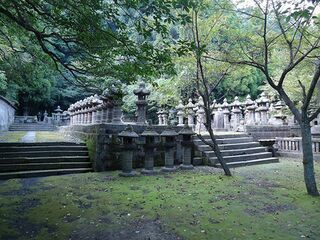Shimazu Shigehide

Shimazu Shigehide was the 25th head of the Shimazu clan and eighth Edo period lord of Satsuma han, ruling the domain from 1755 to 1787. He is known especially for his support for Western Studies, and for his relatively open policies regarding travel and exchanges between Satsuma and other provinces. Whereas travelers were generally not permitted to enter within the borders of the domain for much of the Edo period, during Shigehide's reign this was relaxed.
He was a son of Shimazu Shigetoshi, and succeeded his father as head of the clan and of the domain in 1755, at age ten. Until he reached his majority in 1760 (at age 15), Shimazu Hisamoto served as an unofficial regent for the young daimyô. Shigehide married in 1763, at the age of 18.[1]
It is said that Shigehide desired to bring more commerce and trade into the domain, and believed that greater merchant activity was essential for a prosperous castle town; as a result, he relaxed the domain's strict border policies, known as the strictest in the realm, and sometimes even referred to as "the closed country within the closed country."[2] He showed a strong interest in European culture and knowledge, calling upon a number of Dutch factors to talk with him at his Edo mansion, including Hendrik Doeff in 1806, Johannes Frederik van Overmeer Fisscher in 1822, and Philipp Franz von Siebold in 1826. He is also said to have acquired some proficiency in writing in the Dutch language.
Shigehide established a number of academic institutions within the domain, including a college for training in both military & literary arts in 1773, a medical college the following year, and in 1779, an astronomical observatory and mathematics academy called the Meiji-kan; later renamed Tenmonkan, this site grew to become the chief center of urban culture in Kagoshima.[3] He also oversaw the construction of botanical gardens in Kagoshima and in Edo, for the study of herbs and medicines.
In 1827, he established a treasure museum within his Edo mansion. In 1832, he celebrated his 88th birthday in Edo; that same year saw a Ryukyuan embassy to Edo, which met with likely the greatest number of (retired, acting, and future) Shimazu lords ever gathered in one place, as Shigehide, his son the retired lord Narinobu, Narinobu's son the active lord Narioki, and Narioki's heir at that time, Shimazu Nariakira, were all present at the Shimazu Edo mansions.
His concubines included Chima no kata, eldest daughter of the court noble Tsutsumi Toshinaga, whose direct descendants would include the famous Atsuhime.[4] Shigehide's children included his successor as lord of Satsuma, Shimazu Narinobu (1774-1841), as well as three other sons who were adopted into other daimyô families and became lords of their own domains. These were Shimazu Masataka (lord of Nakatsu han in Buzen province, adopted by Okudaira Masao), Shimazu Narihiro (lord of Fukuoka han, adopted by Kuroda Narikiyo), and Shimazu Nobuyuki (lord of Hachinohe han, adopted by Nanbu Nobumasa). Shigehide's daughter Shige-hime, meanwhile, was married into the Tokugawa clan, becoming the chief wife of Shogun Tokugawa Ienari.[5] After becoming father-in-law to the shogun, Shigehide requested and received special privileges when visiting Edo castle, including having the way cleared for him of other people (including other daimyô and their retainers) as he made his way from the palanquin-dismounting place to the genkan (entrance foyer) of the honmaru palace.[6]
He is buried in the Shimazu clan cemetery at Fukushô-ji in Kagoshima, alongside two of his wives, and his daughter Keihime.[7]
| Preceded by: Shimazu Shigetoshi |
Lord of Satsuma han 1755-1787 |
Succeeded by: Shimazu Narinobu |
References
- John Whitney Hall, Tanuma Okitsugu (1719-1788): Forerunner of Modern Japan, Harvard University Press (1955), 91-92.
- ↑ Miyagi Eishô 宮城栄昌, Ryûkyû shisha no Edo nobori 琉球使者の江戸上り, Tokyo: Daiichi Shobô (1982), 199.
- ↑ Gallery labels, Reimeikan Museum, Kagoshima, Sept 2014.
- ↑ Plaques on-site at Tenmonkan.
- ↑ Plaque at grave of Chima no kata, Shôjôke-in, Teramachi-dôri, Kyoto.
- ↑ Kaiyô kokka Satsuma 海洋国家薩摩, Kagoshima: Shôkoshûseikan (2010), 58-59.
- ↑ Yamamoto Hirofumi, Edo jidai - shogun bushi tachi no jitsuzô, Tokyo shoseki (2008), 70-71.
- ↑ Plaques on-site at Fukushô-ji.